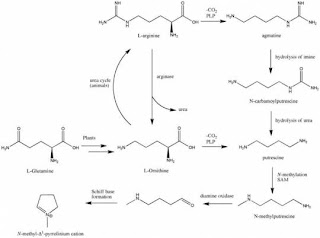Flavonoids have a basic skeleton of 15 carbon terdiriu atomkarbon, in which two benzene rings (C6) bound to a chain of propane (C3) to form an arrangement of C6-C3-C6. This arrangement can produce three kinds of structure of flavonoid compounds. This arrangement can produce three jenisstruktur, the 1.3-diarilpropan or flavonoids, 1.2-diarilpropan or isoflavones, dan1,1-diarilpropan or neoflavon.
Of the various types of flavonoids, flavones, flavonols, and anthocyanidins are the kind that are found in nature, so it is often stated as the main flavonoids. While the types of flavonoids in nature in limited quantities is calkon, Auron, katecin, flavanones, and leukoantosianidin.
The number of flavonoid compounds in nature and not due to the many variations in structure, but are caused by different levels of hydroxylation, alkoksilasi, or glycosylation of the structure.
All variants of the flavonoid biosynthesis correlated because the groove itself, yaiut linesSikimat and acetate-malonate pathway. The model of the biosynthesis of flavonoids has beensuggested by Birch. According Birch, the steps of the biosynthesis of flavonoids pertamadari aC6-C3 berkombinasi units with three units C2 menghasilakan -C3-C6 units (C2 + C2 + C2). C15framework that has been dihasilakan darikombinasi oxygen containing functional groups onyangdiperlukan position. A ring of the flavonoid structure derived from the polyketide route,yaitukondensasi of three units of acetate or malonate. While the B ring and three atomkarbon of the propane chain is Adari phenylpropanoid path (via shikimic.) Therefore, the basic structure of the carbon product darikombinasi biosynthesis of flavonoids between two major avenues for the aromatic ring, called shikimic and acetate-malonate path . As a result of various perubahanyangcaused by enzymes, the third carbon atom of the propane chain can produce a variety offunctional groups, such as double bonds, hydroxyl, carbonyl groups, and so on.
Structure of flavonoids undergo secondary reactions, sepertihidroksilasi, oxidation(including training carbonyl), glycosylation, methylation, isoprenilasi, cyclization, and the other for the treatment of enzimyang present in the organism. The product of the enzymatic reactiondapatmenghasilkan flavonoid compounds with different types kerangkadasar different as shownon the classification of flavonoids klasifikasiatau above (Tukiran, 2010)
Figure 9. Principal reaction Flavonoid Biosynthesis
According biosynthesis, the formation of flavonoid started denganmemperpanjang unitsfenilpropanaid (C3-C6) derived from p-amino derivatives sinamatseperti kumarat, times kafeatacid, ferulic acid, or asamsinapat. The experiments have also shown that calkon and flavanonesisomer are comparable also serves as an intermediate in the biosynthesis of various types of otherflavonoids.






